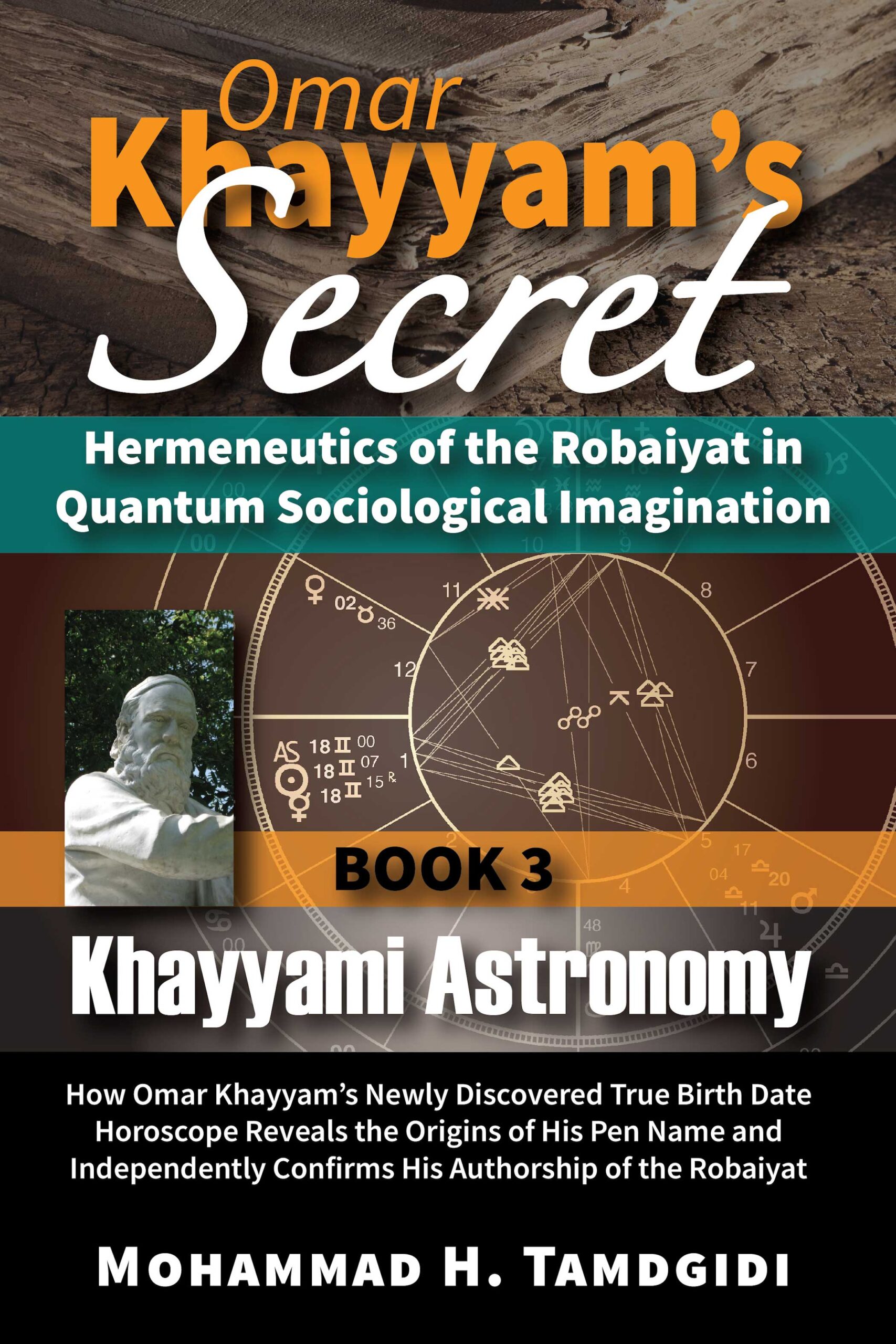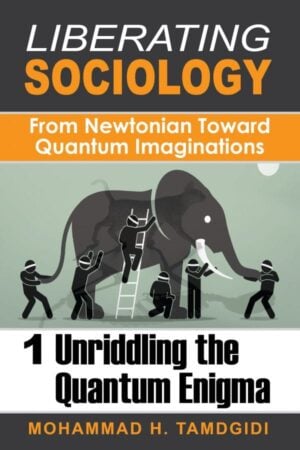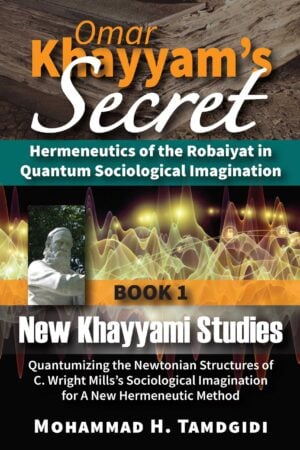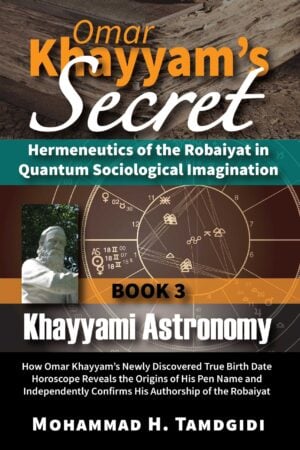Book Section: CHAPTER VI — The Case of A Second Signature Robai of Omar Khayyam, Reporting Its Author to Have Turned A Centenarian — by Mohammad H. Tamdgidi
$20.00
This essay, titled “The Case of A Second Signature Robai of Omar Khayyam, Reporting Its Author to Have Turned A Centenarian,” is the sixth chapter of the book Khayyami Astronomy: How the Newly Discovered True Birth Horoscope of Omar Khayyam Reveals the Origins of His Pen Name and Independently Confirms His Authorship of the Robaiyat, which is the third volume of the twelve-book series Omar Khayyam’s Secret: Hermeneutics of the Robaiyat in Quantum Sociological Imagination, authored by Mohammad H. Tamdgidi.
Description
Abstract
This essay, titled “The Case of A Second Signature Robai of Omar Khayyam, Reporting Its Author to Have Turned A Centenarian,” is the sixth chapter of the book Khayyami Astronomy: How the Newly Discovered True Birth Horoscope of Omar Khayyam Reveals the Origins of His Pen Name and Independently Confirms His Authorship of the Robaiyat, which is the third volume of the twelve-book series Omar Khayyam’s Secret: Hermeneutics of the Robaiyat in Quantum Sociological Imagination, authored by Mohammad H. Tamdgidi.
A second quatrain that has also been missing in nearly all recent collections, abroad or in Iran, among the Khayyami Robaiyat is a curious quatrain that otherwise had a wide presence at least since the 14th century AD until early twentieth century in many older sources that Swāmī Govinda Tīrtha (1941) consulted for listing his so-called “Known” Khayyami quatrains.
This quatrain has appeared in two main versions, though some subvariations have also been reported for it. The first version A, below, was included and translated by E. A. Whinfield (1883) in his collection of Khayyam’s quatrains, numbered 395. As it appears in Tīrtha’s The Nectar of Grace (1941:276), and numbered in his collection variously either as xi.12, or 873, it is rendered as the version B below, as translated by Tīrtha.
Tamdgidi advises especially the English speaking reader in advance not to be concerned too much with the confusing way this particular quatrain has been handled across manuscripts over the years. The confusion itself is the story of this quatrain, and it is the understanding of the confusion itself that can provide us with an illustration of what havoc Tīrtha inadvertently wreaked in Khayyami studies for decades by misreading Khayyam’s horoscope and offering an erroneous birth date for Khayyam.
Following a detailed study of social context and substantive contents of the various sources and versions of this quatrain, Tamdgidi demonstrates and concludes these two robais are from the same poet, Omar Khayyam, the variation having existed perhaps in the original notes in one version or another. They found their way to other poets in one variation or another because these others were interested in Khayyam’s poems. Having remained in their papers, the poems were mistakenly assumed to be authored by these others, one version preferred for another because of the knowledge that the vagrant poet was deemed not to have lived to a hundred years of age.
The quatrain versions do not represent two separate poems resulting from two different poets. They are too similar to be assignable to two (or more) different poets. The quatrain in both versions are from the same poet, Omar Khayyam, who lived to both lunar and solar hundred years of age, who is claiming to have reached the age of hundred, when he was still in a sound mind to revise his earlier version to announce his having become a centenarian, thanking his God whom he had tried throughout his life to know “to the best of his ability,” including by way of composing quatrains such as the one explored in this chapter.
In fact, the author claim that this quatrain also serves as another signature quatrain for Omar Khayyam as part of a broader collection he must have been working on throughout his life.
In the translation, in the fourth line, Tamdgidi has introduced the notion that the “sins” Khayyam is referring to may be the very quatrains he was writing, an example of which was this quatrain itself. When in his last day he died asking God to forgive him since he tried to know Him to the best of his ability, Khayyam must have that same sentiment in mind. He was asking for forgiveness in the specific sense that how he had gone about knowing God itself implied for others the sin of critical-mindedness, an attitude that he, and in his view his God, would not consider “sinning” but seeking to know God in the sincerest way possible to humanity created in the image of God, with (within its earthly bounds) free will.
Version B:
آنم كه پديد گشتم از قدرت تو
پرورده شدم بناز در نعمت تو
صد سال به امتحان گنه خواهم كرد
يا جرم منست بيش يا رحمت تو
— رباعى عمر خيّام
I’m he who from Thy power to existence came,
And in Thy kind bounties cultivated became.
For hundred years test my sins to see which is more:
These misdeed or Thy mercy forgiving the same.
— Omar Khayyam Robai (Tamdgidi translation)
Version A:
آنم كه پديد گشتم از قدرت تو
صد ساله شدم بناز در نعمت تو
صد سال به امتحان گنه خواهم كرد
يا جرم منست بيش يا رحمت تو
— رباعى عمر خيّام
I’m he who from Thy power to existence came,
And amid Thy kind bounties a hundred became.
For hundred more years test my sins to see what’s more:
These misdeed or Thy mercy forgiving the same.
— Omar Khayyam Robai (Tamdgidi translation)
Recommended Citation
Tamdgidi, Mohammad H. 2021. “CHAPTER VI — The Case of A Second Signature Robai of Omar Khayyam, Reporting Its Author to Have Turned A Centenarian.” Pp. 215-250 in Omar Khayyam’s Secret: Hermeneutics of the Robaiyat in Quantum Sociological Imagination: Book 3: Khayyami Astronomy: How Omar Khayyam’s Newly Discovered True Birth Date Horoscope Reveals the Origins of His Pen Name and Independently Confirms His Authorship of the Robaiyat. (Human Architecture: Journal of the Sociology of Self-Knowledge: Vol. XVI, 2021. Tayyebeh Series in East-West Research and Translation.) Belmont, MA: Okcir Press.
Where to Purchase Complete Book: The various editions of the volume of which this Book Section is a part can be ordered from the Okcir Store and all major online bookstores worldwide (such as Amazon, Barnes&Noble, Google Play, and others).
Read the Above Publication Online
To read the above publication online, you need to be logged in as an OKCIR Library member with a valid access. In that case just click on the large PDF icon below to access the publication. Make sure you refresh your browser page after logging in.







